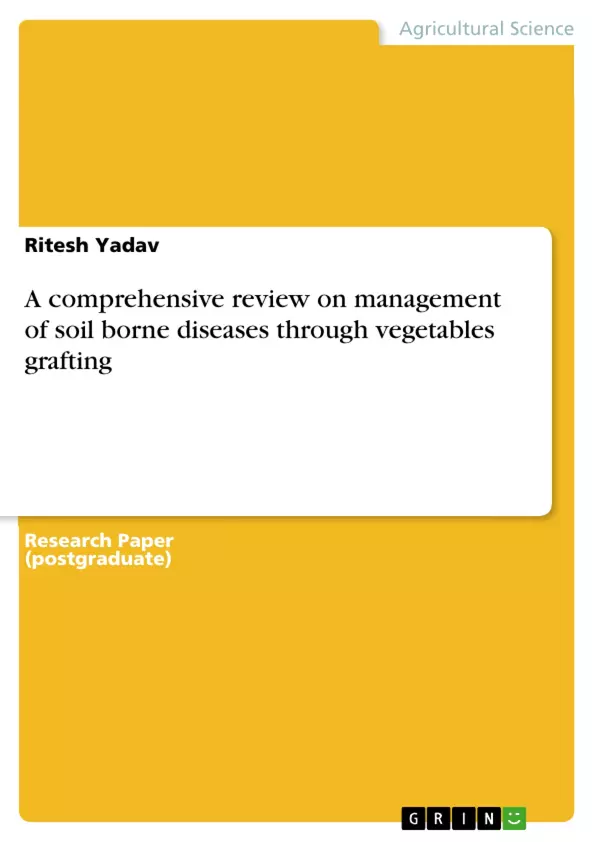Grafting is a method of asexual propagation where two living plant parts (the rootstock and scion) are united together to grow as a single plant. Although grafting in fruits and nuts is an ancient technique, vegetable grafting is relatively a recent innovation and has emerged as one of the most important integrated pest management strategy to manage soil borne pathogens and insect pests of solanaceous and cucurbitaceous vegetable crops at the turn of 20th century. The earliest reports from Japan included the use of Cucurbita moschata to confer Fusarium wilt resistance in watermelon production (Oda 2002; Sakata et al 2007, 2008). Grafting as a disease management tactic has rapidly expanded to solanaceous and cucurbitaceous vegetables due to the factors viz. increased pathogen inoculum densities due to intensification of production practices, reliance on susceptible cultivars to meet specific market demands , global movement and local invasion of novel pathogens, increased use of organic practices, the rapid adoption of high tunnel production systems, use of appropriate technologies for resource-limited farmers and the ban on methyl bromide via Montreal Protocol (Sakata et al 2007). The recent use of semi-automated grafting machines and grafting robots ensures higher grafting speed, higher survival rate of grafted plants, reduces the higher price of grafted seedlings, and thus encourages the cultivation of grafted plants among small-scale farmers. In addition, grafting provides advantages to manage abiotic stress, to reduce reliance on chemical and fertilizer inputs, and to enhance fruit quality and yield (Colla et al 2010a, b; Proietti et al 2008; Rouphael et al 2008a, b).
Inhaltsverzeichnis (Table of Contents)
- Introduction
- History of Grafting in Vegetables
- Current Status of Vegetable Grafting
- Diseases controlled by Grafting in Vegetable production
- Approaches to combat biotic stress in vegetable grafting
- Basic Prerequisites of Grafting
- Grafting methods in Vegetables
- Defense mechanisms in disease resistance of grafted vegetables
- Success Stories of Grafting as an effective approach against soil borne pathogens in vegetable production
- Dangers of Grafting
- Future Prospects
- Conclusions
- References
- Introduction
- What is Grafting?
Zielsetzung und Themenschwerpunkte (Objectives and Key Themes)
This comprehensive review aims to provide an in-depth analysis of the role of vegetable grafting in managing soilborne diseases. The review explores the history of grafting in vegetables, its current status, and the various diseases it can control. Additionally, it examines the mechanisms behind disease resistance in grafted vegetables and explores the challenges and future prospects of this technique.
- The history and evolution of grafting in vegetables.
- The effectiveness of grafting in managing soilborne diseases in vegetable production.
- The mechanisms by which grafting enhances plant defense against pathogens.
- The challenges and potential risks associated with widespread reliance on grafting.
- The future prospects and potential applications of grafting in sustainable vegetable production.
Zusammenfassung der Kapitel (Chapter Summaries)
The introductory chapter defines soilborne plant pathogens and their impact on vegetable crops, emphasizing the complexities of managing diseases caused by these pathogens. The review delves into the historical background of grafting in vegetables and its emergence as a significant pest management strategy in the 20th century. The chapter also explores the various diseases that can be effectively controlled by grafting, specifically focusing on Fusarium wilt, Phytophthora blight, Verticillium wilt, and root knot diseases. It highlights the importance of understanding the specific characteristics of each pathogen and its dynamics within the soil environment for successful disease management through grafting. Additionally, the chapter examines the various grafting methods employed in vegetable production, including the benefits and drawbacks of each technique. Lastly, it provides an overview of the defense mechanisms that contribute to the disease resistance observed in grafted vegetables, focusing on the role of the rootstock in mediating the plant's response to pathogens.
Schlüsselwörter (Keywords)
Vegetable grafting, soilborne pathogens, disease management, integrated pest management, Fusarium wilt, Phytophthora blight, Verticillium wilt, root knot nematodes, rootstock selection, plant defense mechanisms, sustainable agriculture.
- Quote paper
- Ritesh Yadav (Author), 2018, A comprehensive review on management of soil borne diseases through vegetables grafting, Munich, GRIN Verlag, https://www.grin.com/document/444420



